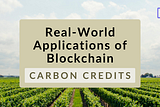Blockchain’s Next Big Fix: Carbon Credits
Real-World Applications of Blockchain

For years, blockchain has been tied to the rise (and fall) of cryptocurrencies. But the real story isn’t about coins, but about the structure of blockchain and what happens when you use it to rebuild systems that have been broken for decades.
We’ve already seen glimpses of it: instant global payments that bypass banks. Shipping containers tracked across oceans without a mountain of paperwork. Medical records that belong to the patient instead of being locked away by insurance providers or hospital networks. These are no longer just dreams, but living examples of how blockchain untangles complexity and restores trust.
Now, it’s being applied to one of the most complex and high-stakes markets in the world: carbon credits.
The Problem With Carbon Credits
Carbon credits have always sounded good on paper: reward farmers for reducing emissions and let businesses offset their footprints. The problem? The system behind carbon credits, and the larger environmental credit market, is a mess.
Verification drags on for months, the auditing process is untrustworthy, and credits sometimes get double-sold. Not to mention, the people actually making the impact — the farmers, landowners, and local communities — often get the smallest cut.
The idea works. The system doesn’t.
Why Blockchain Fits Like a Glove
Carbon markets are the exact type of trust problem blockchain was built for. With blockchain:
- Every action can be verified as it happens: Emission reductions are measured, confirmed, and stored directly on-chain, creating transparent, tamper-proof proof of impact.
- Every credit is unique: Tokenization prevents duplication or resale.
- Transactions don’t stall: Smart contracts automatically handle issuance, sales, and retirement.
- Fairness gets built in: With fewer middlemen, more money flows to the people actually creating the climate benefit.
In short, blockchain makes carbon credits work like they were always supposed to.
Grow’s Real-World Application
That’s where Grow comes in. Grow is using blockchain to turn carbon credits into a transparent, efficient, global system.
- Farmers adopting regenerative practices can have their impact verified and monetized directly.
- Buyers can finally trust that what they’re purchasing is authentic, unique, and permanently retired once used.
Behind it all is a system that removes the need for blind trust — every credit is traceable, verifiable, and connected to real-world data. This results in an environmental market that finally works as intended: measurable action, transparent proof, and value flowing back to the people creating the impact.
The Bigger Shift
What’s happening with carbon credits is bigger than just one market. It’s a preview of blockchain’s real role in the world: not flashy speculation, but rewiring the systems we all rely on. Finance. Trade. Healthcare. Climate.
An environmental credits system like Grow’s show us what’s possible when blockchain is applied to real-world problems. These broken systems can finally work.
Want to learn more?
If you’d like to understand better how environmental credits work, check out Grow’s explainer blog: What Are Environmental Credits? A Beginner’s Guide to the Climate Economy.
Then explore how farmers are already putting those ideas into practice in Grow’s blog: How Farmers Are Winning Big in the New Climate Economy.
And if you’re interested in exploring more real-world applications of blockchain beyond agriculture, revisit our earlier post: The Real-World Fix: How Blockchain Is Quietly Rebuilding Broken Systems.
This is a part of the Connect Blockchain Academy blog series. Explore our other Blockchain Academy blog posts below:
- What is a Block Explorer?
- What is Blockchain Governance?
- The ABCs of Web3
- Staying Safe Online
- Nodes 101
- The Voting Process in Blockchain
- How to Spot Scammers and Fake Profiles in the Blockchain Space
- AI 101: How Artificial Intelligence is Already Helping You
- AI 102: Surprising Ways AI Can Make Your Life Easier
- AI 103: How to Write the Perfect AI Prompt
- Decentralization 101: Who’s Really In Charge?
- Centralization 101: When One Group Has All the Power
- How Blockchain Is Quietly Rebuilding Broken Systems
- NFTs 101: What NFTs Can Actually Do
- Crypto Wallets 101: How They Work and Why You Need One
- The Real-World Utility of Crypto (And What Pizza Has To Do With It)
- World’s First Social Impact Platform Powered by Web4 (and New Connect Terminology)
- How to Get Involved and Strengthen a Community
- Native and Ethereum and Bridging, Oh My!
- AI 104: AI is Getting Scary Good — Here’s What to Watch For
- Decentralization 102: Taking Back Control
- DEX Trading 101: What DEX Has in Common with Local Farmers Market
- Stablecoin Bill Passed, Bitcoin Soars
- Not All Crypto is the Same, How to Tell them Apart
- DYOR 101: How to Do Your Own Research
- Connect Launches Blockchain Academy and Crypto Academy on the World’s First Social Impact Platform
- What Does It Mean to Be On-Chain?
- Node Governance: Understanding Distribution on the Blockchain
- NFTs 102: The Evolution of Ownership to the Digital Space
- AI 105: The Secret to Sharper AI Answers — Assign a Role
Disclaimer:
The views expressed in this material do not necessarily reflect those of Connect. The information provided is solely for educational purposes and should not be considered as financial advice. We strongly encourage individuals to conduct their own research and exercise independent judgment before making any financial decisions. Connect holds no responsibility for any actions taken based on the information provided.
Listen To The Article

Black Friday 30%
Offer









